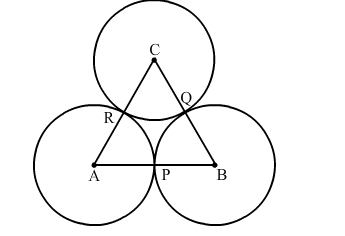In the given figure, three circles with centres A, B, C, respectively, touch each other externally. If AB = 5 cm, BC = 7 cm and CA = 6 cm, the radius of the circle with centre A is

(a) 1.5 cm
(b) 2 cm
(c) 2.5 cm
(d) 3 cm
(b) 2 cm
Given, $A B=5 \mathrm{~cm}, B C=7 \mathrm{~cm}$ and $C A=6 \mathrm{~cm}$.
Let, $A R=A P=x \mathrm{~cm}$.
$B Q=B P=y \mathrm{~cm}$
$C R=C Q=z \mathrm{~cm}$
(Since the length of tangents drawn from an external point are equal)
Then, $A B=5 \mathrm{~cm}$
$\Rightarrow A P+P B=5 \mathrm{~cm}$
$\Rightarrow x+y=5 \ldots \ldots(i)$
Similarly, $y+z=7 \ldots \ldots \ldots($ (ii)
and $z+x=6 \ldots(i i i)$
Adding (i), (ii) and (iii), we get:
$(x+y)+(y+z)+(z+x)=18$
$\Rightarrow(x+y+z)=9 \ldots \ldots .(i v)$
Now, $(i v)-(i i):$
$(x+y+z)-(y+z)=(9-7)$
$\Rightarrow x=2$
$\therefore$ The radius of the circle with centre A is $2 \mathrm{~cm}$.
